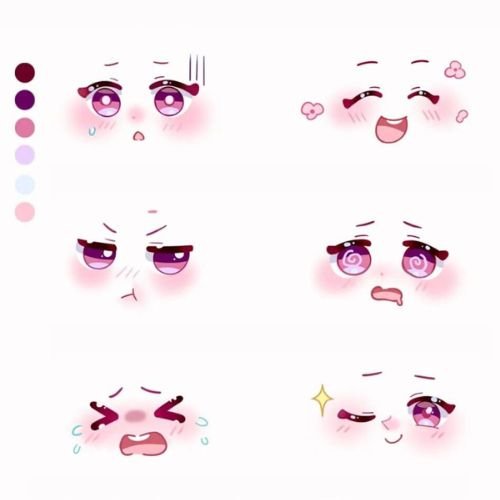
In this comprehensive guide, I’ll take you on a journey through the delightful realm of chibi facial expression drawing. We’ll explore the reasons why this art form is so endearing, dive into the techniques for understanding and mastering facial expressions, and learn how to bring your chibi characters to life with a diverse range of emotions.
Why Chibi Facial Expression Drawing is Adorable
Chibi art is characterized by its distinctive style, featuring characters with oversized heads, large eyes, and diminutive bodies. This playful and whimsical approach to character design lends itself perfectly to the expression of emotions through the face. The exaggerated features of chibi characters create an instant connection with the viewer, evoking a sense of warmth, playfulness, and pure adorableness.
One of the key reasons why chibi facial expression drawing is so captivating is its ability to convey a wide range of emotions in a highly expressive and endearing manner. From the innocent, wide-eyed wonder of a curious chibi character to the mischievous grin of a playful one, these miniature masterpieces have the power to tug at our heartstrings and bring a smile to our faces.
Understanding Facial Expressions
To master the art of chibi facial expression drawing, it’s essential to have a solid understanding of the basic principles of facial expressions. Facial expressions are the primary means by which we convey emotions, and by studying the subtle nuances of how the eyes, eyebrows, mouth, and other facial features interact, we can learn to create more authentic and compelling chibi characters.
Some key elements to consider when studying facial expressions include:
- Eye Shape and Position: The eyes are often the most expressive feature of the face, conveying emotions such as surprise, happiness, sadness, and anger.
- Eyebrow Movement: The positioning and movement of the eyebrows can greatly influence the overall expression, from a furrowed brow indicating concern to raised eyebrows expressing curiosity.
- Mouth Shape and Position: The mouth is a versatile feature that can convey a wide range of emotions, from a wide grin to a pursed, worried expression.
- Cheek Movement: The subtle changes in the cheeks, such as rosy blushes or puffed-out cheeks, can add depth and nuance to a chibi character’s expression.
By understanding these fundamental elements of facial expressions, we can begin to translate them into the exaggerated and endearing world of chibi art.
Basic Techniques for Chibi Facial Expression Drawing
Now that we’ve explored the foundations of facial expressions, let’s dive into the specific techniques for creating captivating chibi facial expressions. As with any art form, practice and experimentation are key, but there are some essential techniques to keep in mind:
- Exaggeration: One of the hallmarks of chibi art is the exaggeration of features, and this principle applies to facial expressions as well. Don’t be afraid to push the boundaries of realism and amplify the emotional impact of your chibi characters.
- Simplification: While chibi art may be exaggerated, it’s also important to maintain a sense of simplicity. Focus on the essential elements of each expression and avoid overcrowding the face with too many details.
- Consistency: Developing a consistent style for your chibi facial expressions is crucial for creating a cohesive and recognizable body of work. Experiment with different approaches until you find a style that resonates with you and your audience.
- Gesture and Posture: Remember that facial expressions don’t exist in isolation; the overall posture and body language of your chibi characters can greatly influence the emotional impact of their expressions.
By mastering these basic techniques, you’ll be well on your way to crafting adorable and expressive chibi characters that captivate your viewers.
Common Facial Expressions in Chibi Drawing
Chibi art is renowned for its ability to convey a wide range of emotions through exaggerated facial expressions. Some of the most common and beloved chibi facial expressions include:
- Happiness: A wide, toothy grin with rosy cheeks and sparkling eyes, conveying pure joy and excitement.
- Surprise: Enlarged, round eyes and an open, “O”-shaped mouth, expressing a sense of wonder and astonishment.
- Shyness: Downcast eyes, flushed cheeks, and a small, timid smile, evoking a sense of bashfulness and vulnerability.
- Anger: Furrowed brows, narrowed eyes, and a tight-lipped frown, conveying frustration and irritation.
- Curiosity: Slightly tilted head, wide eyes, and a puckered, inquisitive expression, reflecting a desire to learn and explore.
By mastering the art of depicting these common chibi facial expressions, you’ll be able to create a diverse and engaging cast of characters that captivate your audience.
In this comprehensive guide, we’ve embarked on a journey through the adorable world of chibi facial expression drawing. We’ve explored the reasons why this art form is so captivating, delved into the techniques for understanding and mastering facial expressions, and learned how to bring your chibi characters to life with a diverse range of emotions.
As you continue to hone your skills in chibi facial expression drawing, I encourage you to experiment, explore, and have fun with the process. Remember, the key to creating truly engaging and expressive chibi characters lies in your ability to connect with the emotions and personalities you’re trying to convey.
I hope this guide has inspired you to dive deeper into the adorable world of chibi art and unlock the full potential of your creative talents. Happy drawing!











